Upperco, Baltimore County, Maryland, USA (photos a composite of races 2004-2007)
We tried to make it to the demolition derby at least once a summer back in the day when the kids were young. For those who may be uninitiated to the concept, the main goal is to keep your vehicle running while attempting to disable others. There are a couple of variations depending on whether it’s a short-track race or a true “last man standing” demolition derby, but they both involve smashing other cars while trying to avoid being smashed. Driver and spectator safety are main considerations so it’s not nearly as dangerous as it seems. Everyone is stringently protected through aggressive supervision and on-site precautions. This is actually designed to be a family-friendly event, and kids love it.
We went to races sponsored by the Upperco Volunteer Fire Company in Upperco, Maryland, a quiet rural spot in northern Baltimore County. The Fire Company held races each summer as a creative fundraiser to purchase the latest firefighting equipment, to protect the 3,000 people who live within their jurisdiction. The races are located 2 miles south of Hampstead or 6 miles north of Reisterstown on Maryland Route 30. Take Arcadia Ave. off of Rt. 30 and follow the signs (map).
Apparently, all these years later, the demolition derby still continues! I might have to stop by again for old time’s sake.
Pre-Race Preparations
A small hillside forms a natural amphitheater, and a level, rectangular track has been bulldozed into the bottom of the hill. Spectators park along the slopes on two sides. Some people bring recreational vehicles or trailers and set-up for the day with grills, coolers, tables, chairs and canopies, to watch the competition from the comfort of their personal tailgate parties. Others leave their cars and walk down to the viewing stands. There are plenty of vendors if people need food or anything else. One of the drivers became so prolific that he opened his own souvenir stand!
Drivers brought their cars down to the track before the race started. I think this may have been a pre-race meeting to either inspect the cars or review the rules. The rules really are meant to for the protection of everyone involved, such as: minimizing the amount of gasoline allowed in the cars; requiring approved seat belts and helmets; and chaining doors shut.
Short Track Begins
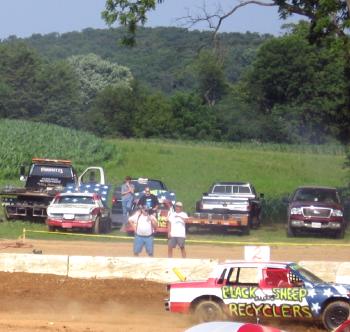
The racing day begins with short track competitions. The object here is to get around the track as many times as possible in a given amount of time. Cars gain initial momentum by hurling down the hillside as they charge through the racetrack entrance. Oftentimes cars clog as they enter the track or during the first curve so those who get there before the pack gain an advantage.
Notice the background in this photograph. This side of the track is reserved for race crews, officials and safety personnel. The flatbeds and pickups delivered cars to the track earlier in the day and will haul away the broken wrecks that evening. Corn grows in the fields behind the track.
And Continues
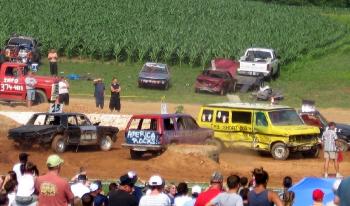
Earthen pylons built around tractor tires mark each corner of the short track. Cars must remain on the outside of these pylons as they circle the field in a clockwise direction. There are two features that add to the excitement. First, there isn’t a lot of room between pylon and wall so cars tend to get stuck in corners. Second, the track is indeed incredibly short so when a car breaks free it’s right around the track and back into the same mess again. Cars will smash each other trying to get past these obstructions to break free.
It only get worse as disabled vehicles start to block the few remaining paths. They have to be shoved or pushed aside by blunt force. It’s common for cars to flip upside down. A referee stops the action briefly, summons a bobcat onto the track, and the car is flipped upright. If it can still run it’s back in the race. Others catch fire. The Upperco Volunteer Fire Company breaks out its hoses, and once again, if the car can move under its own power it’s back in the game.
Time expires and those having traveled the most laps move on to the next round. The pounding of hammers can be heard from the pit area as crews feverishly bang and stretch metal back into decent enough shape to compete in the money rounds.
The Demolition Set-Up
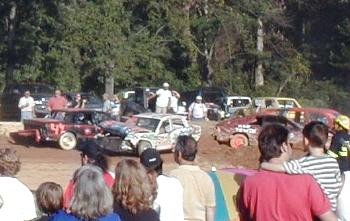
True demolition derbies take place after the short track races. Size and weight makes a difference and many of the favorite cars seem to be old clunkers made of solid American steel during the 1970’s. Bobcats clear pylons from earlier track races and craft an obstruction-free dirt rectangle. A row of cars park along each short side of the rectangle, trunks facing towards the opposing bank. When the competition begins, cars fly across the open space and smash into those traveling in the other direction in a jarring trunk-to-trunk crunch.
The Main Attraction
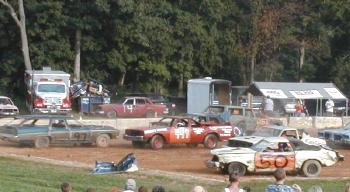
Strategy becomes important after the initial collisions. Drivers use their trunks as battering rams to disable the others. Key blows are made up front in an attempt to damage radiators, engine parts, or other vital pieces that could disable the vehicle. Participants are in a constant battle to lead with their back while protecting their front. It’s almost impossible to avoid being hit with so many cars moving simultaneously. Soon incapacitated cars litter the field. The last car moving under its own power wins.
Spectating
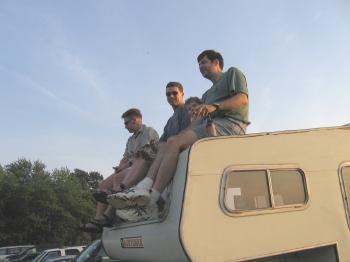
While there really are no bad seats in the house, nothing beats a birds-eye view of the action from the top of an RV as the sun sets on another day of racing. The Upperco demolition derby definitely proves the maxim: “There’s no fun like redneck fun!”

Leave a Reply